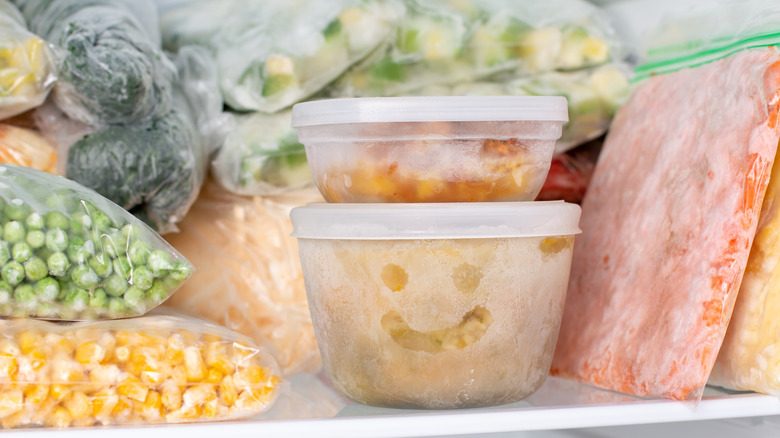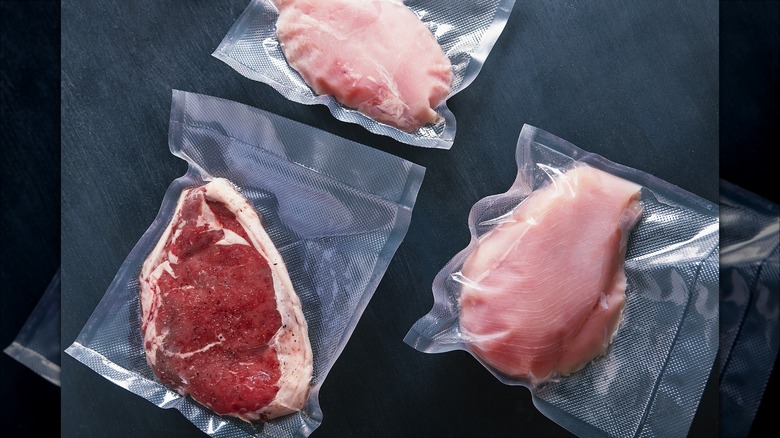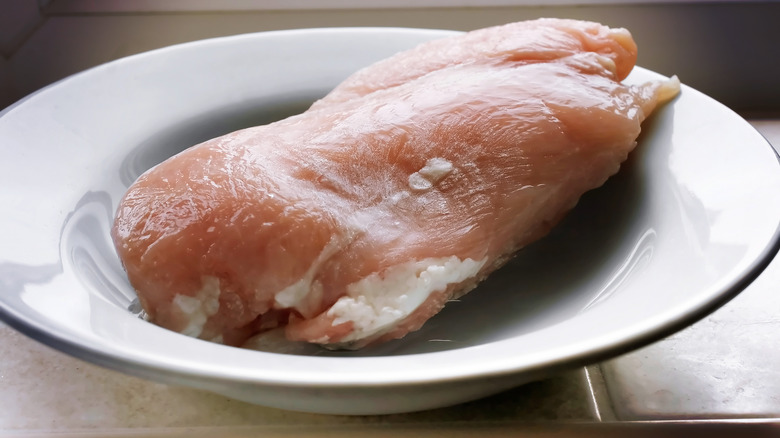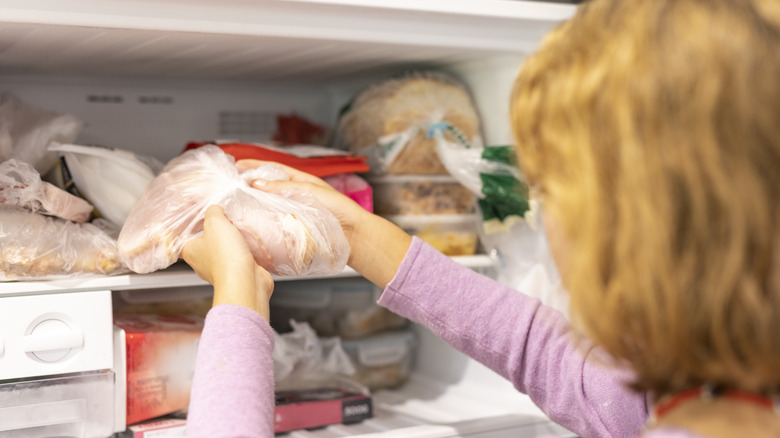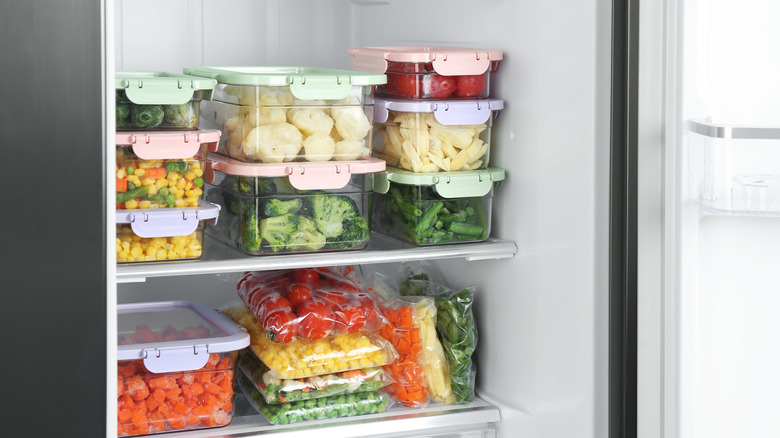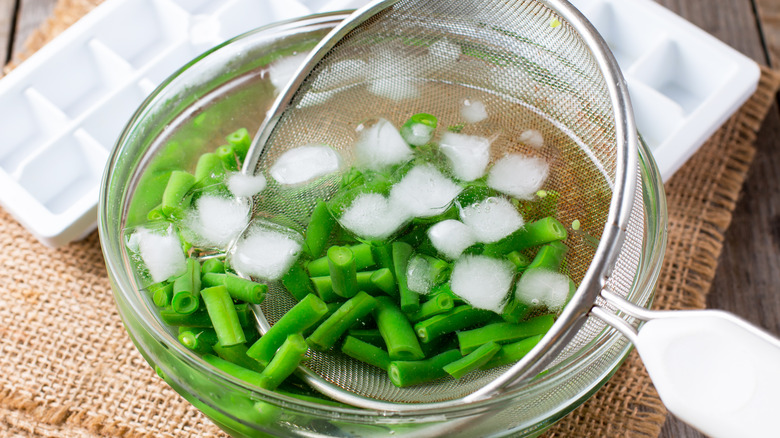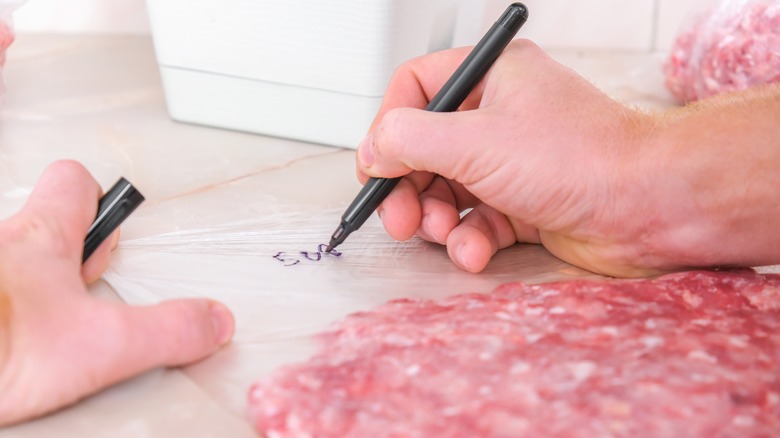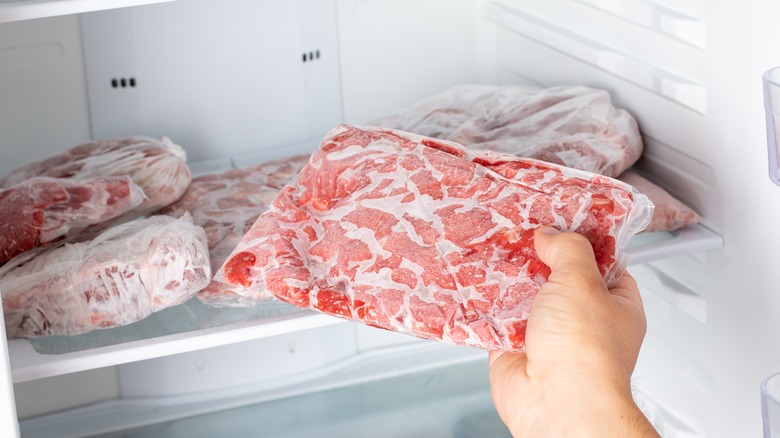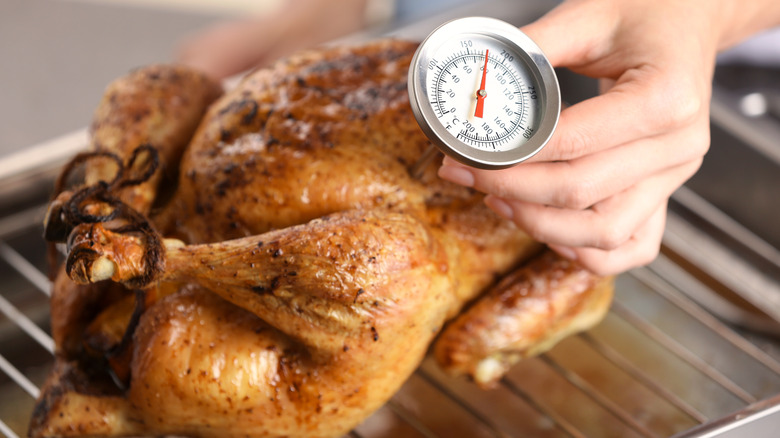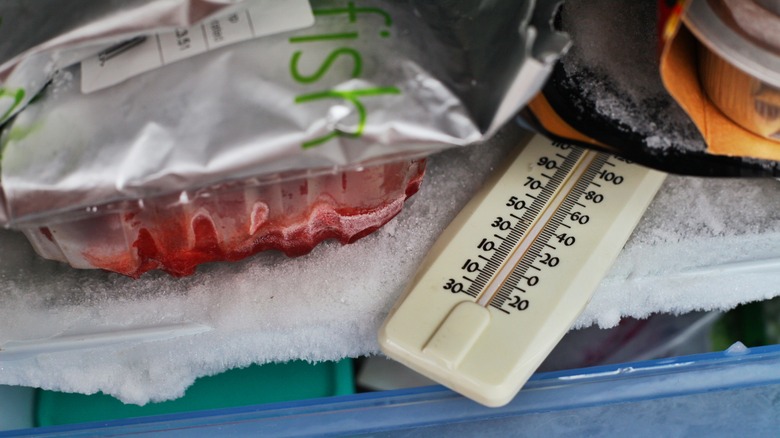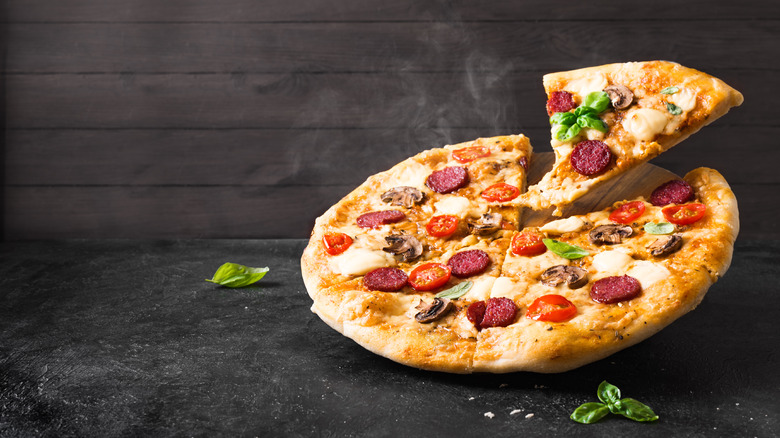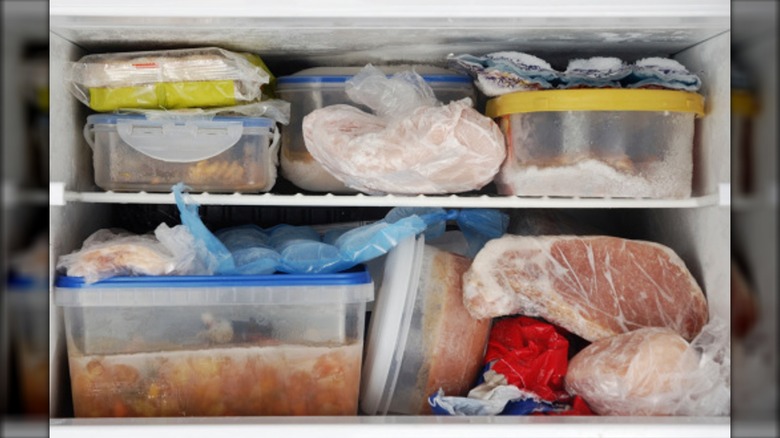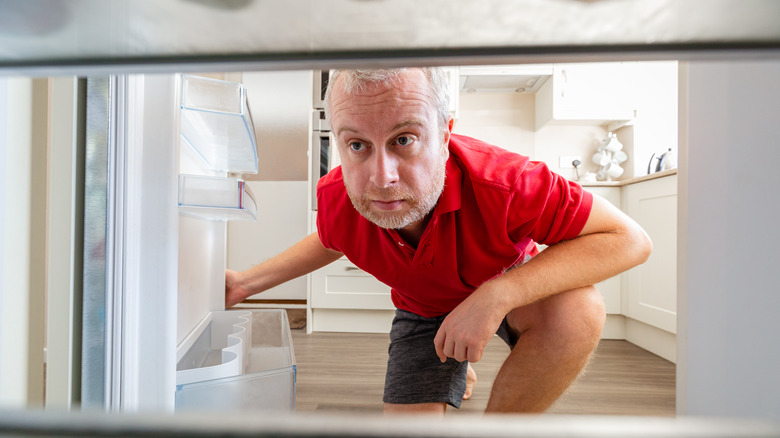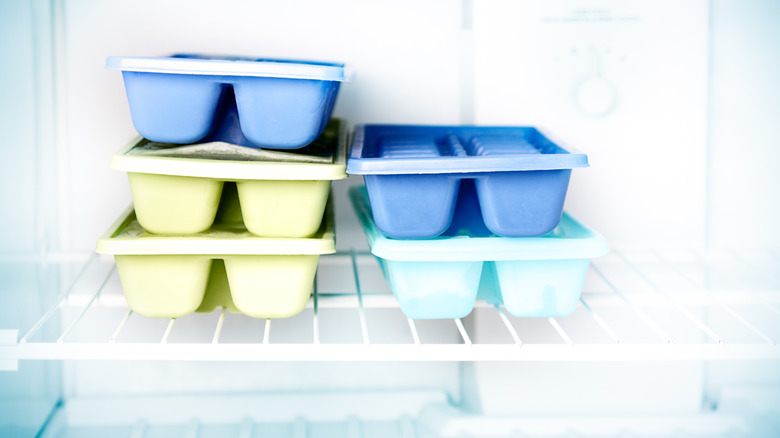14 Frozen Food Mistakes You Might Be Making
The ability to freeze food offers several benefits. It makes it possible to purchase meat in bulk and save it for later use. If you make too much food or have an overabundance of produce, you can freeze the excess to enjoy at a later date, helping to cut back on food waste. When you have a freezer full of food, it can also make it easier to prepare meals. You don't have to run out to the grocery store on a near daily basis to gather the ingredients you need; you can simply remove them from the freezer and defrost them.
However, as convenient as it is to be able to freeze foods, there are many different mistakes that people often make when using this method of long-term storage. Some of these mistakes can have a negative impact on the food's quality, while other mistakes are related to food safety and could be putting your health or that of others in the home at risk. Don't compromise food safety or taste; read on to learn how to avoid some of the most common frozen food mistakes.
1. Waiting too long to freeze the food
One of the biggest mistakes you can make related to freezing food is waiting too long to get the items in the freezer. Regardless of whether you purchased meat from the grocery store that you want to repackage for a later date or made too much spaghetti and want to freeze some for dinner in a few weeks, you want to limit how long the items sit out at room temperature. The United States Department of Agriculture explains that there is a "two-hour rule" about leaving perishable foods out.
If food is left out at room temperature for longer than two hours, the temperature of the food is more likely to fall between 40 and 140 degrees Fahrenheit. This temperature range — referred to as the "Danger Zone" — allows for the ideal conditions for salmonella, E. coli, staphylococcus, and other types of bacteria to grow and multiply rapidly. In fact, they may double as quickly as every 20 minutes.
Making it a point to get the food in the freezer quickly, or at least refrigerate it until you'll be ready to repackage it, will help keep it out of the Danger Zone. Note that the allowable time frame for food to be left out is just one hour if the temperature exceeds 90 degrees. So, if you're planning to freeze any leftover food from an outdoor picnic or barbecue, you'll need to act even more quickly to package the items and get them where they belong.
2. Not thawing frozen food in a safe way
Having a freezer full of food can make answering the "what's for dinner?" question a little easier. However, you still need to plan ahead to leave yourself enough time to safely defrost the items you want. Thawing frozen meats and other items by leaving them on the counter or placing them in hot water is not safe. Both of these methods can allow for bacterial growth because the outer layers will defrost much more quickly than the center. This means they'll enter that Danger Zone where bacteria can start multiplying rapidly, while the center will still need more time to thaw.
To minimize the chances of getting food poisoning, opt for a safer method instead. The best choice is to put the food you want to thaw in the refrigerator and let it slowly defrost. For most items, this will mean transferring them to the fridge the night before. (Leave some additional time when thawing larger items, such as a whole turkey or a large roast.) If you don't have time to defrost food in the refrigerator, another option is to seal the food in a leak-proof bag or container and place it in cold water. Drain and replace the water every 30 minutes to prevent the food from warming up too quickly.
In a pinch, you can also use the microwave to defrost frozen food. However, you'll want to cook the thawed food immediately, as parts of it may start to cook in the microwave. Failing to cook it immediately after defrosting will mean that these partially cooked items could remain in the Danger Zone.
3. Refreezing food that has been thawed outside of the refrigerator
Some people may have been taught that it is not safe to refreeze frozen food that has already been thawed. However, this is not totally accurate. It is safe to refreeze food that has been thawed in the refrigerator. This also applies to refreezing meat, poultry, or seafood purchased from the grocery store that has been previously frozen. Just note that thawing and refreezing food can affect its quality, so it isn't something you'll want to do repeatedly. Also, do not refreeze previously frozen items that have been left out at room temperature for too long. The two-hour rule still applies to make sure their temperature stays away from the Danger Zone.
However, while you can refreeze food that was thawed in the refrigerator, the same is not true for items you defrosted in cold water or in the microwave. These foods must be cooked before refreezing to prevent bacterial growth and limit the chances of foodborne illnesses.
4. Not packaging items correctly to ensure quality
The last thing you want to do is put some food in the freezer with a plan to use it later, only to pull it out and discover that it is completely covered with freezer burn. While eating foods that have freezer burn is safe, it is not desirable. Freezer burn means that the food has lost a lot of its moisture. This can cause meat to turn out overly tough or dry once it has been cooked. Freezer burn can also alter the way the food tastes.
To avoid freezer burn and help the foods you're freezing retain their quality and flavor, it is essential to only freeze food in airtight packaging. Wrapping meat with plastic wrap before placing it into an airtight bag or container can also help protect it. If you plan to store your food in freezer bags, remove as much air as possible from the bag before sealing it. Investing in a vacuum sealer can help remove all of the air to keep food fresher for longer.
5. Not knowing which foods you should blanch before freezing
If you've ever frozen broccoli, zucchini, or other vegetables, you may have noticed that their taste or texture was off after you thawed them to add to a recipe. If this has happened to you, then you likely made the mistake of not blanching them before freezing. Nearly all vegetables should be blanched before freezing. Otherwise, they will start to decay due to enzymes that will remain active even when frozen.
Fortunately, blanching vegetables is relatively quick and easy, so it shouldn't add much more time to the prep work you'll need to do before freezing them. Start by washing and cutting up the veggies. Then, bring a pot of water to a boil and place the cut vegetables into the boiling water. Cook for 1 to 6 minutes, depending on the type of vegetable, and then transfer them into a bowl of ice water. Cooling them quickly will ensure that they stop cooking. Next, drain the water from the vegetables and dry them as much as possible before putting them in an airtight freezer bag or container.
6. Not labeling and organizing frozen food in the freezer
Keeping an organized freezer will make it easier to know exactly what foods you have. It will help you work through your stash and use things up in a timely manner. When your freezer is organized, you're also less likely to purchase something that you already have plenty of in the freezer. To help accomplish this goal, always label each freezer bag or storage container before putting it in the freezer. Include both the date and the contents on the label. If applicable, you can also add reheating instructions or other information to help you prepare the item when it is defrosted.
Then, come up with a system to keep everything organized. The system that works best for you will likely depend on the types of foods you're freezing and the containers you're using. Consider using dividers, baskets, or storage bins to keep everything easy to access. Keeping a running inventory of what's inside the freezer can also help make sure things get used up in a timely manner.
7. Assuming that freezing food will kill dangerous bacteria
Many people incorrectly assume that freezing food will kill any bacteria that is present. While bacteria and other microbes, such as mold and yeast, are inactivated when food is frozen to 0 degrees Fahrenheit, they are not destroyed. This means that any bacteria that are present on the food item will become active once it is defrosted. As with other bacteria, they will start to grow and multiply when given the opportunity.
Don't assume that food that has been frozen can simply be left out for longer than other non-frozen food items you have. The Danger Zone temperature range is still a very real threat, and if the temperature of the food item falls between 40 and 140 degrees Fahrenheit, any bacteria that is present will start to multiply rapidly. Parasites, such as trichina, that are present on food can be killed with freezing. However, in order for this to reliably happen, some very strict criteria must be met, and the food items must be frozen to sub-zero temperatures. Freezing food in a standard freezer at home will not necessarily destroy the parasites.
8. Not cooking frozen food to the proper internal temperature
We've talked a lot about bacteria on food. The Minnesota Department of Health reminds us that cooking food to the proper internal temperature is the best way to kill as many bacteria as possible. Always use a meat thermometer to verify that your steaks, poultry, fish, and other meats are fully cooked. Steaks and pork chops must reach an internal temperature of at least 145 degrees Fahrenheit. Ground meats must be heated to at least 160 degrees Fahrenheit, while all poultry should reach a minimum internal temperature of 165 degrees Fahrenheit. When preparing fish or shellfish, make sure it is cooked to at least 145 degrees Fahrenheit. If you're reheating leftover meat, the internal temperature should read 165 degrees Fahrenheit.
Keep in mind that while cooking food to the proper internal temperature will kill many bacteria, some potentially harmful substances are more resistant. For example, when food is left out on the counter for too long, its bacteria may produce toxins that remain present even after your food is cooked at a high temperature. This is why it is so important to refrigerate food promptly and keep it from entering into the Danger Zone temperature range.
9. Freezing the wrong foods
While the freezer can come in very handy to help preserve many types of food for later use, there are some items that do not freeze well. For example, freezing milk, sour cream, or custard is not a good idea. These items tend to separate in the freezer and may turn out lumpy or watery after thawing.
Many vegetables also don't freeze well. Cucumbers, lettuce, radishes, parsley, cabbage, and celery will become waterlogged when they are frozen. Moreover, they'll be very limp with an off color, flavor, and odor. Freezing plain, cooked pasta or rice is also not a great idea. Once it thaws, the pasta will be rather mushy and unappetizing. You also might want to avoid freezing cooked egg whites. If you do, you'll notice that their texture is way off when thawed. They'll be rubbery and tough. Finally, while fried chicken, fried shrimp, and other fried foods can be frozen, doing so isn't a great idea unless you're okay with them turning out soggy after defrosting.
10. Not keeping your freezer cold enough
If you want the frozen foods in your freezer to last and to maintain the best quality, it is essential to make sure you keep the freezer cold enough. Freezers should be kept at or below 0 degrees Fahrenheit. If the temperature rises above 0 degrees Fahrenheit, the items you have stored in the freezer may not keep as long. If food starts to defrost, it can spoil.
Even if your freezer has a thermostat, it may not be accurate. An appliance thermometer can help you confirm that the temperature is where it should be. After putting the thermometer in the freezer, leave it in place for at least five hours to get an accurate temperature reading. After five hours, you can adjust the temperature, if needed, and come back to check again after another five hours or so.
There is no need to remove the thermometer from the freezer after making sure it is set correctly. In fact, leaving it in there will make it easy to check the temperature with just a quick glance. It will also come in handy if you ever lose power. You'll be able to verify that the freezer is still cold enough once the power comes back on to know whether your food is safe or not.
11. Putting food into the freezer when it is still hot
With all the talk about putting food away quickly and not leaving it to sit out at room temperature for too long, you might think you should put leftovers into the fridge immediately after they're cooked. However, this is not a good idea. Putting any hot food into your freezer is a food safety mistake that can threaten your health.
As Michigan State University shares, putting something in your freezer while it's piping hot will raise the interior temperature of the freezer. The higher temperature could warm up your already-frozen foods, increasing the potential for bacterial growth. Instead of putting hot food in the freezer, leave it out long enough to cool. (You can divide it into smaller portions to help it cool more quickly.) You still need to stay within the two-hour rule for safety. Just monitor the temperature, and freeze the item promptly after it has cooled down enough.
12. Waiting too long to eat frozen foods
With continuous storage at temperatures at or below 0 degrees Fahrenheit, frozen food can remain safe indefinitely. However, just because frozen food won't spoil, it doesn't mean that you're going to want to eat it several months or years down the road. Over time, the quality of the food will start to decrease. This means that its taste or texture (or both) will be off whenever you finally defrost and cook the item.
To ensure the best taste, there are many foods that you'll want to try to use within one or two months of freezing. These include bacon, ham, sausage, hot dogs, and leftover pizza. Frozen raw meat will keep a bit longer. You can store beef, pork, veal, lamb, and poultry for up to one year. However, fish and shellfish generally don't last as long. Many shouldn't be stored for more than a few months.
13. Not knowing whether frozen food is safe after a power outage
Power outages can cause a lot of problems. One big one is letting the food stored in your freezer spoil. However, frozen food doesn't spoil with every power outage. So, how are you supposed to know whether the food in your freezer is safe to eat if the power has been out?
If your freezer is packed full, the food should stay safe for about two days, assuming the door is left shut. Freezers that are not packed full may only keep food frozen for about one day. When the power returns, you'll need to assess the condition of the food in it. Anything that is partly frozen or still has some ice crystals can safely be cooked or refrozen. If the food is as cold as it would be coming out of the refrigerator (40 degrees Fahrenheit), it is also safe to cook or refreeze. Any foods that have warmed up to a temperature greater than 40 degrees Fahrenheit for two or more hours should be discarded. You should also get rid of any items contaminated by juice from thawed packages of raw meat.
The next time your power goes out, be sure to leave the freezer door shut. Avoid opening it to check on the food, as you'll only be introducing warmer air. If you have a friend or family member who has power and some space in their freezer, you might consider transferring some items to their house. Purchasing dry ice or a large ice block and leaving it in the freezer can also help keep your food as cold as possible.
14. Leaving your freezer mostly empty
Leaving your freezer mostly empty is another mistake you'll want to avoid. First, a full freezer will keep food frozen for longer in the event of a power outage. While food may only remain frozen for one day if the freezer is only half full, it should stay frozen for two days if it is packed full.
A full freezer is also more efficient than one that is partly empty. Each time you open the door to the freezer, some warm air gets inside. Every time this happens, the freezer works to cool down the air to maintain the set internal temperature. If the freezer is mostly empty, there is a lot more space for warm air to go. With a full freezer, there will be minimal space for the warm air to fit. This means that the freezer that is partly empty will have to work a lot harder to cool the inside down than the one that is packed full of food.
When you think about how many times you open your freezer, you'll see that all that extra work can really add up. A freezer that doesn't have to work as hard should last longer than one that is constantly struggling to cool warm air. Plus, it should help reduce your energy consumption.
